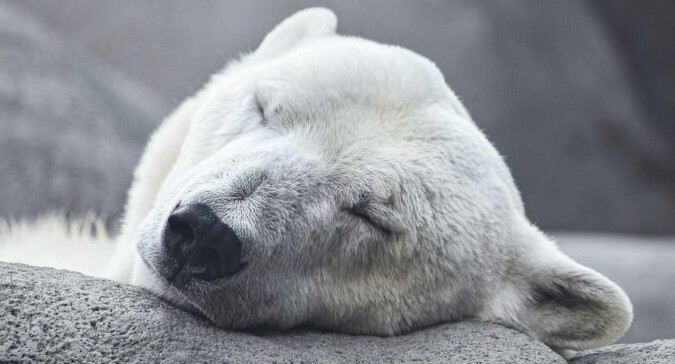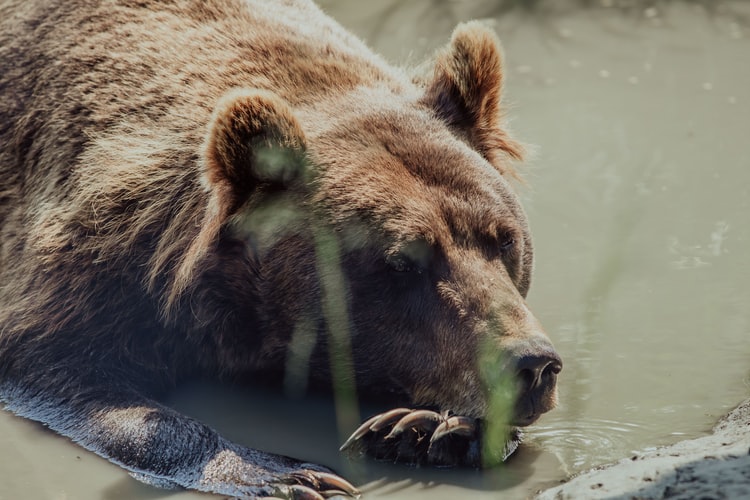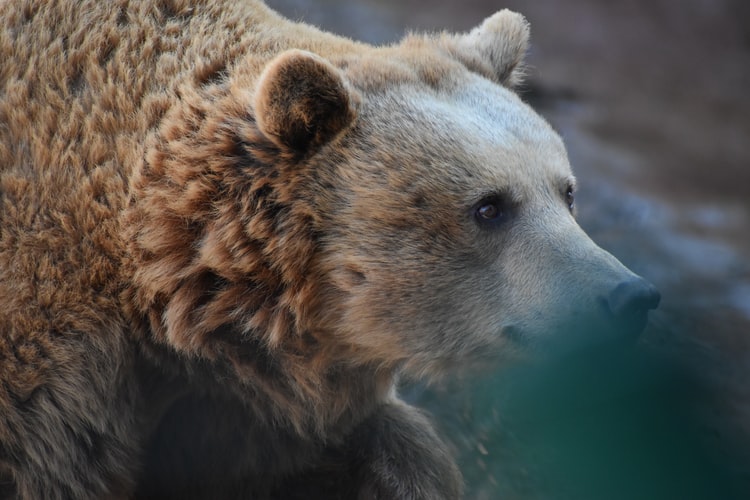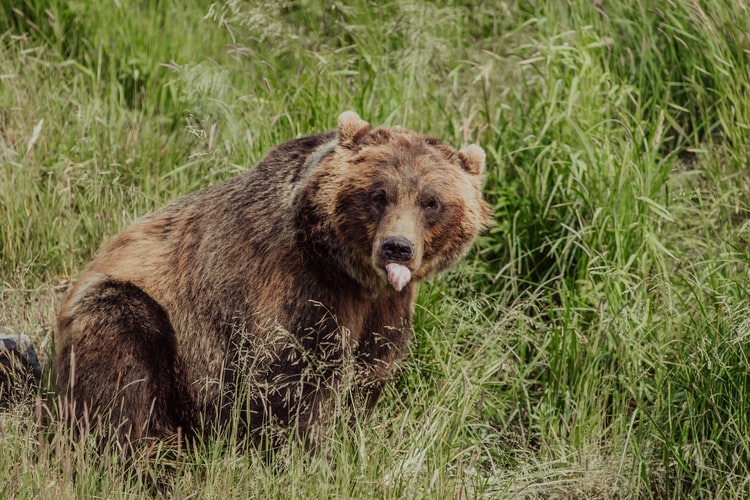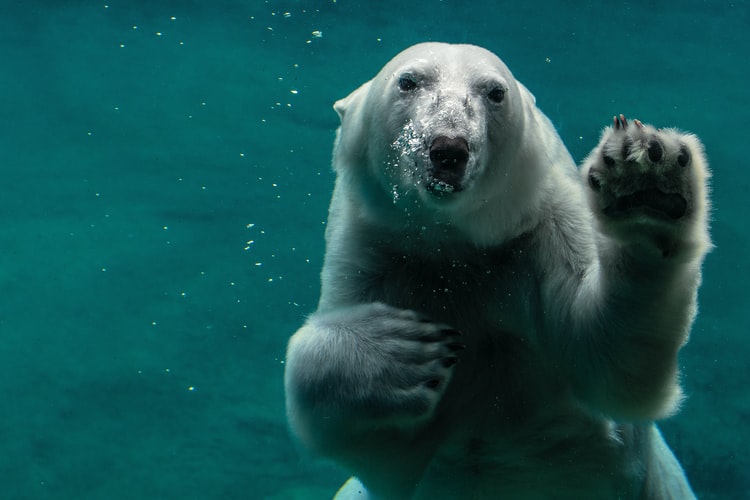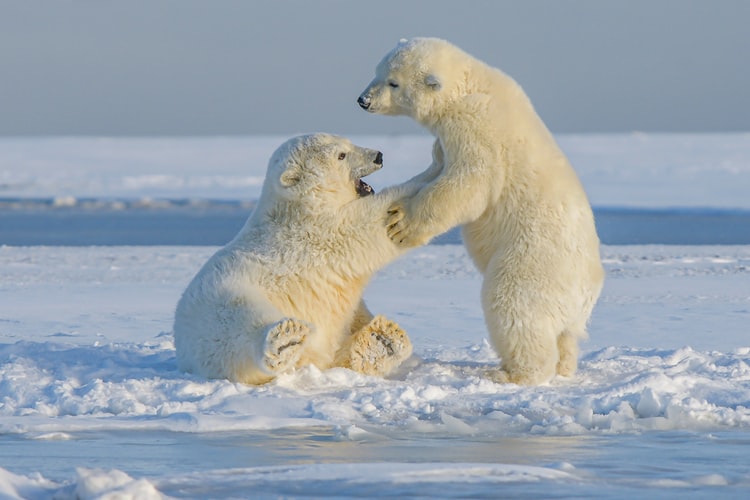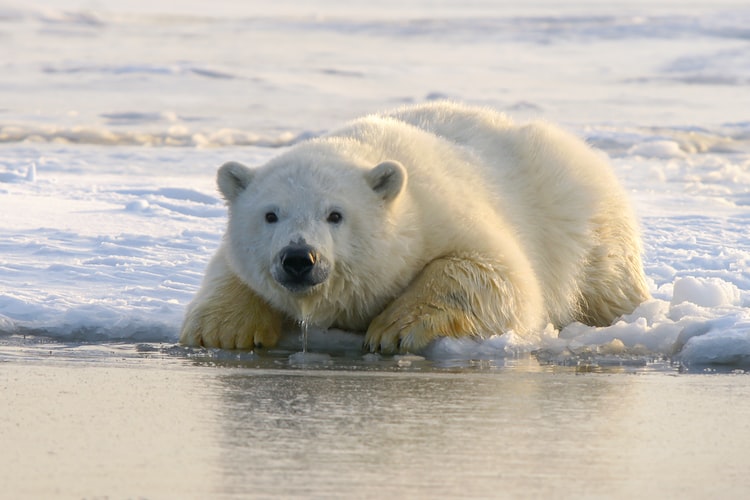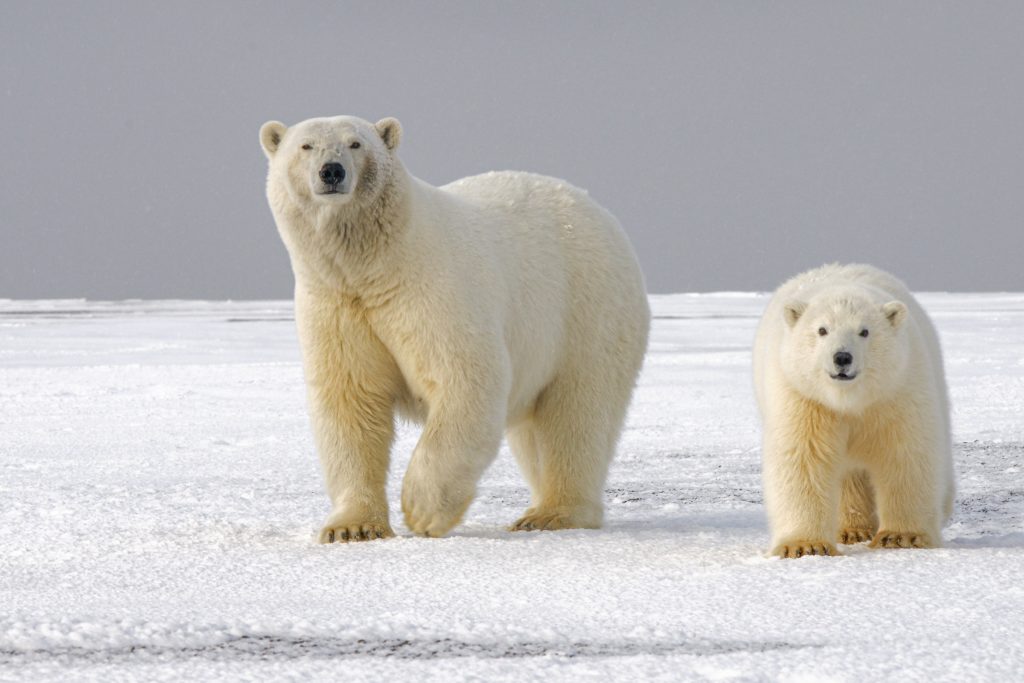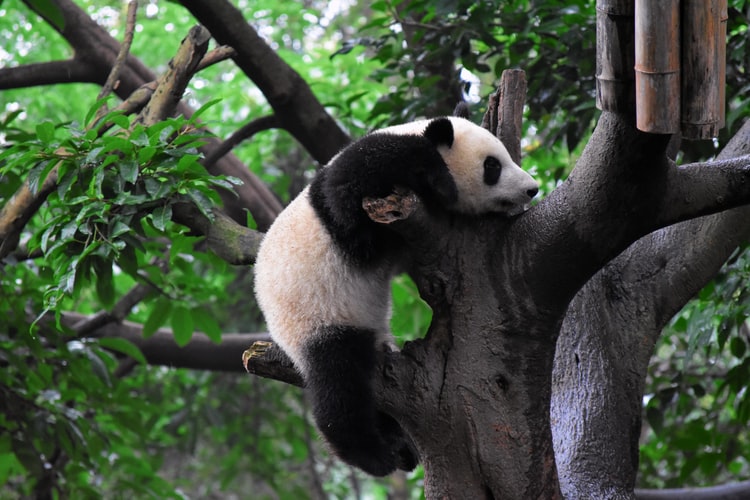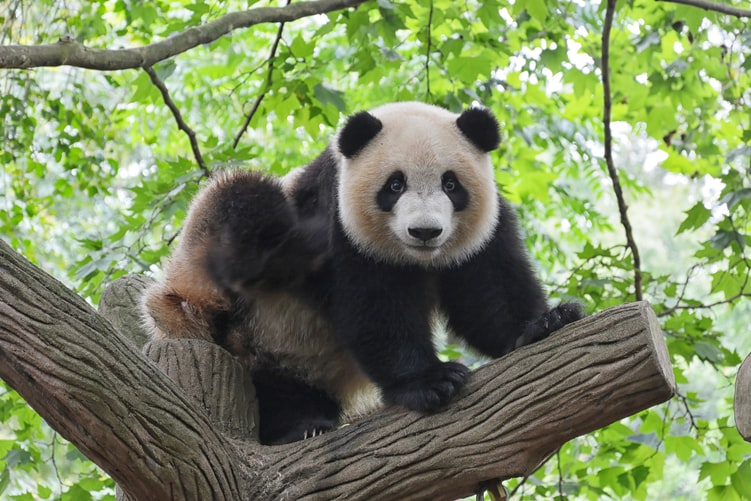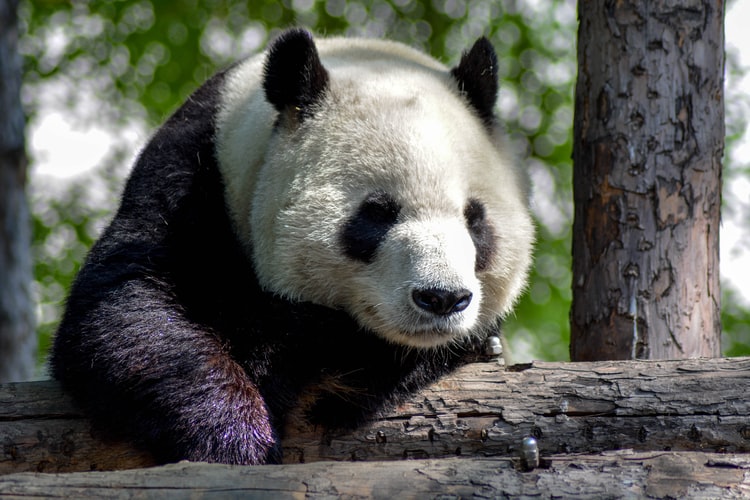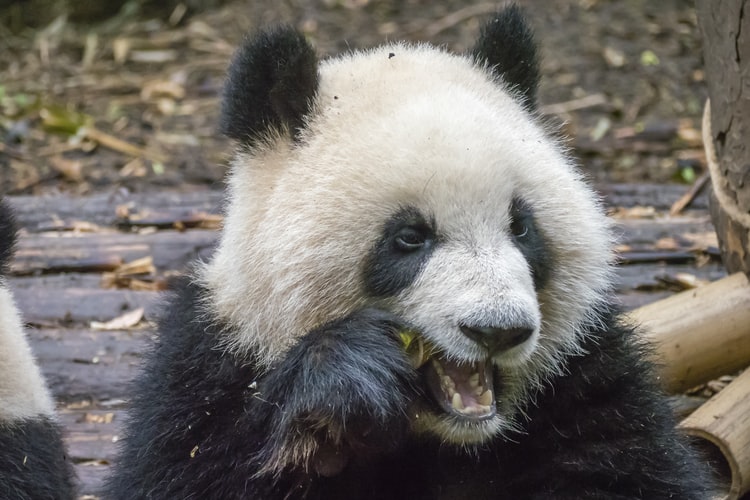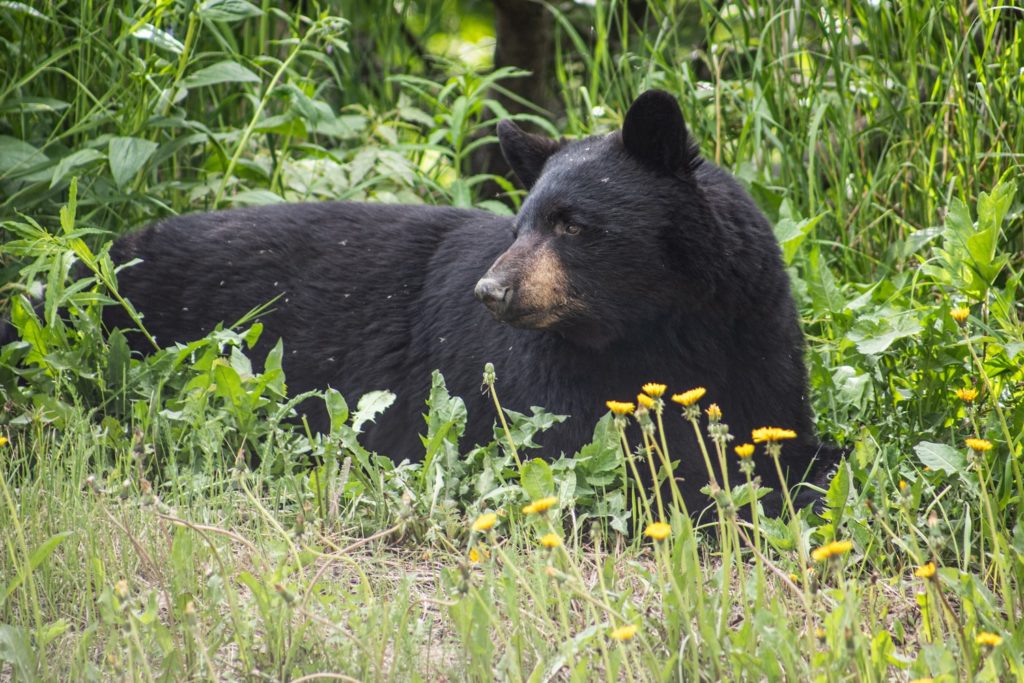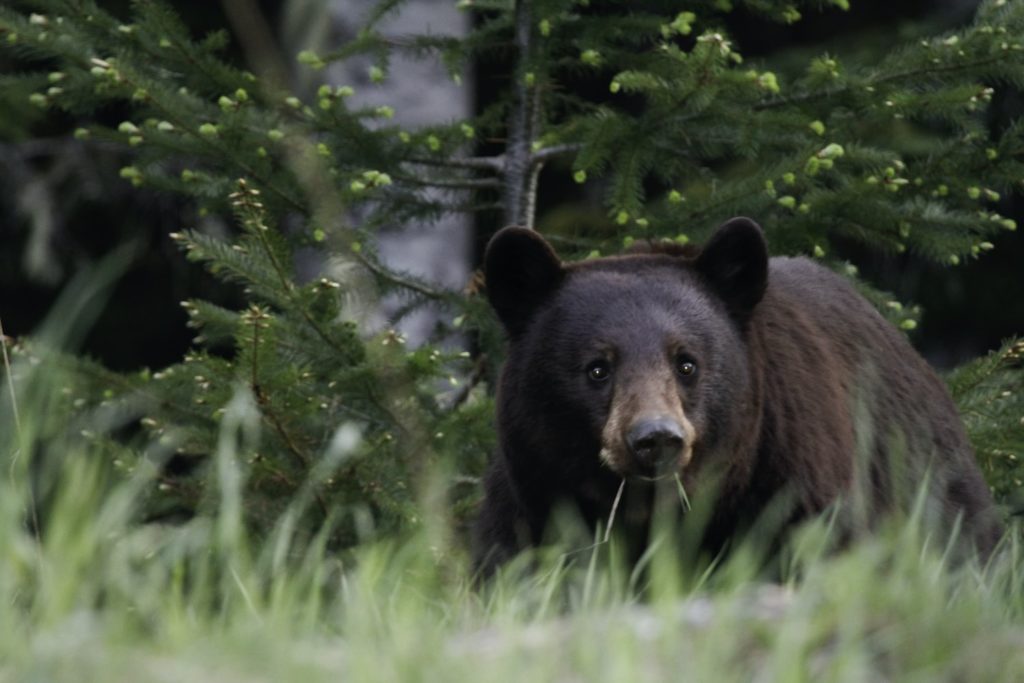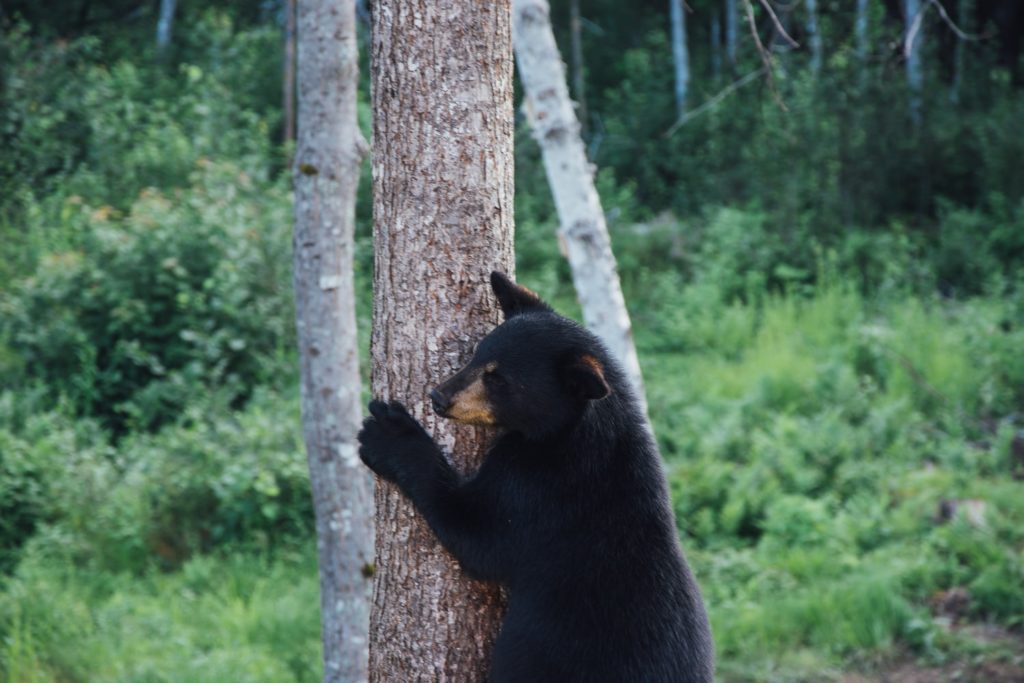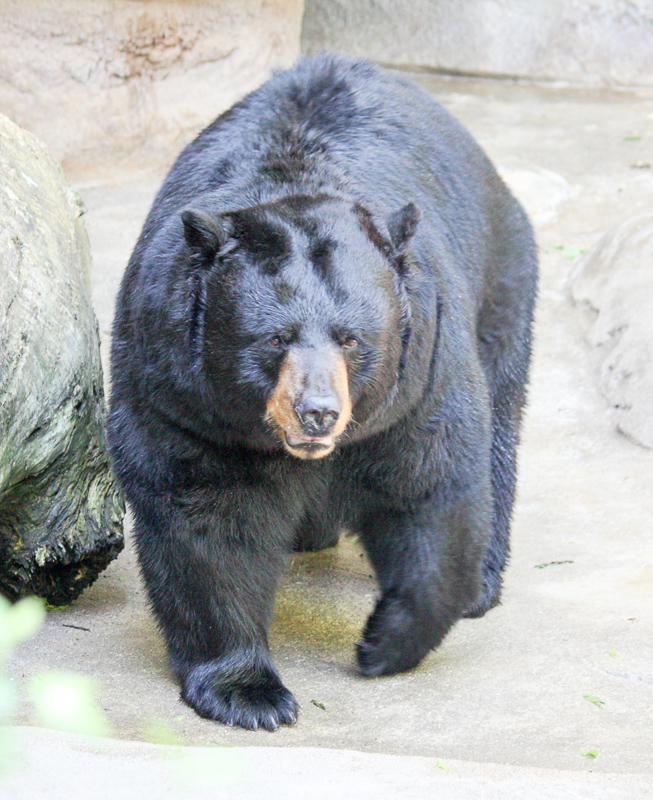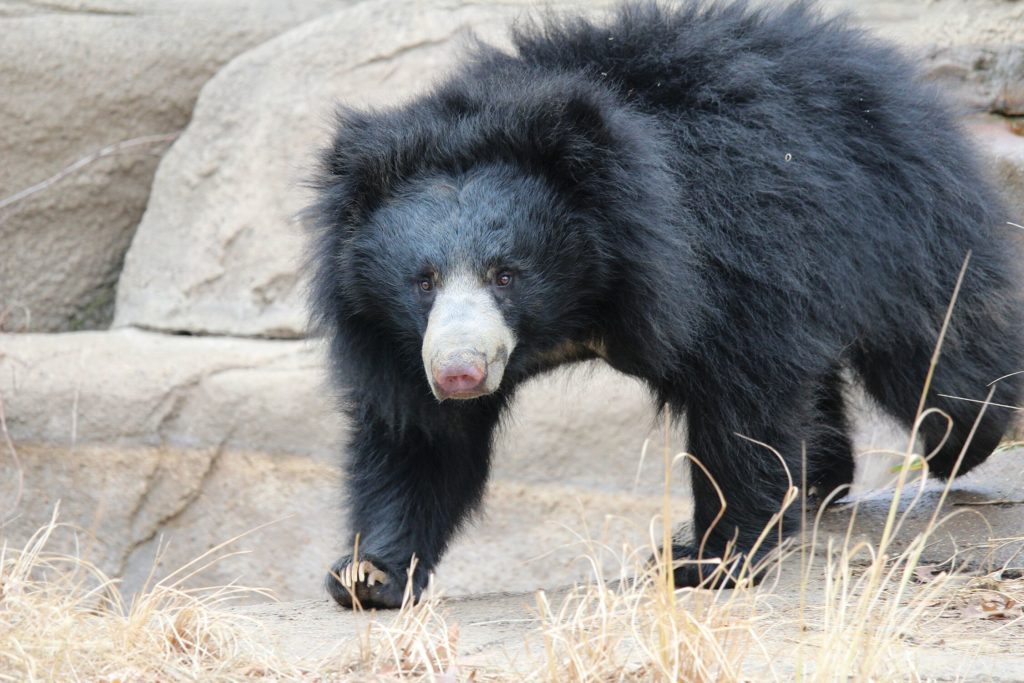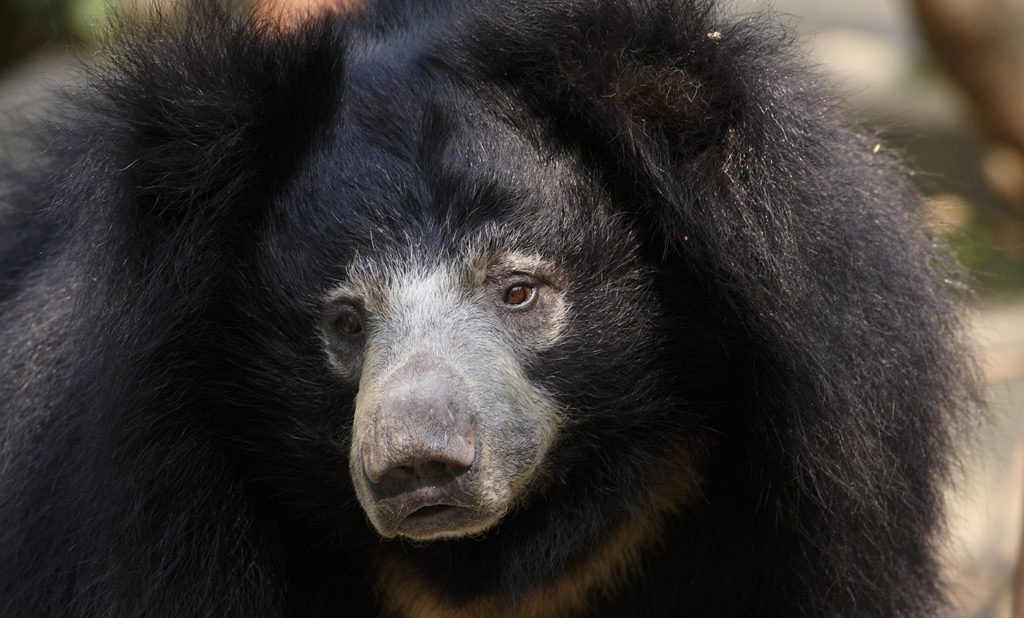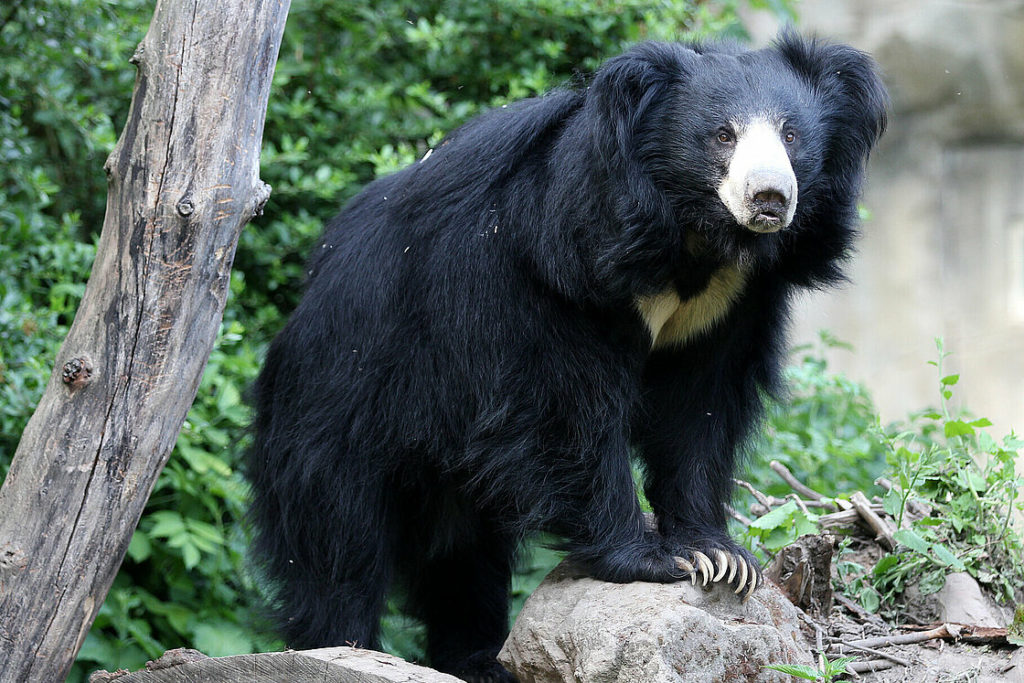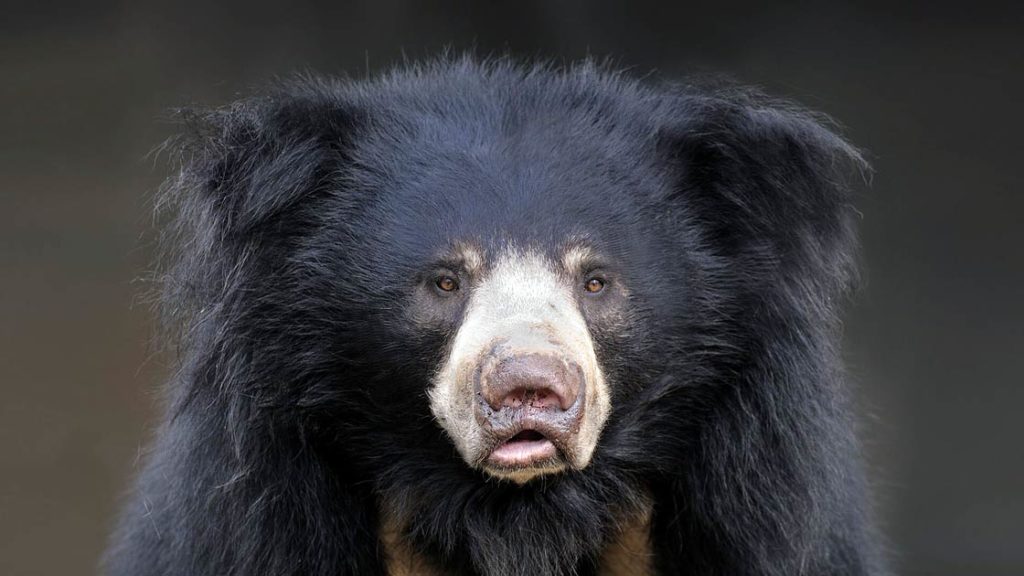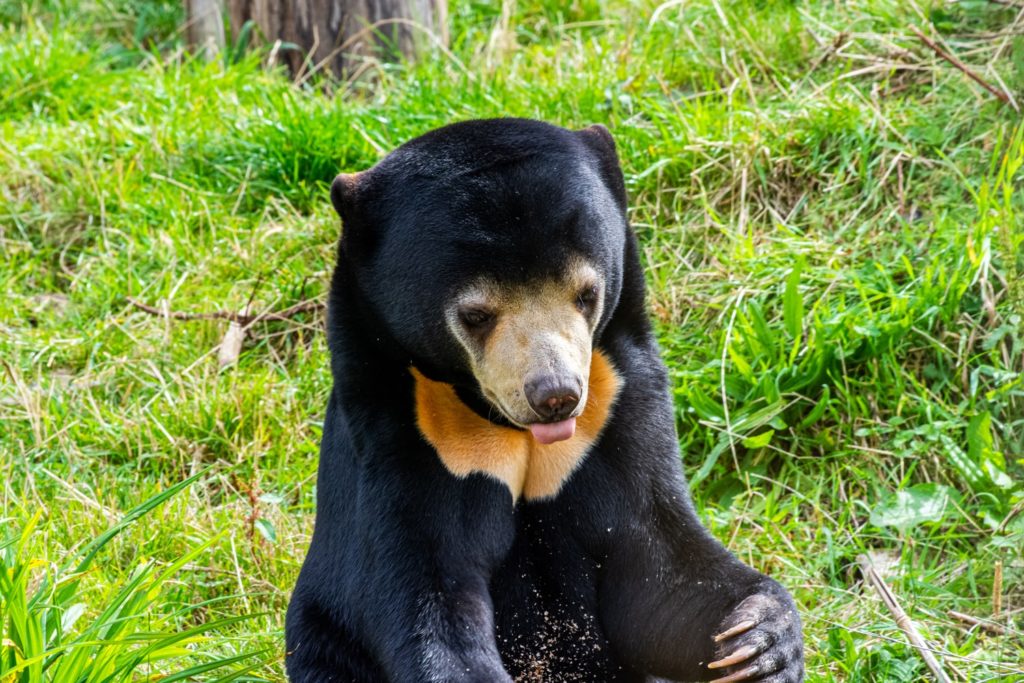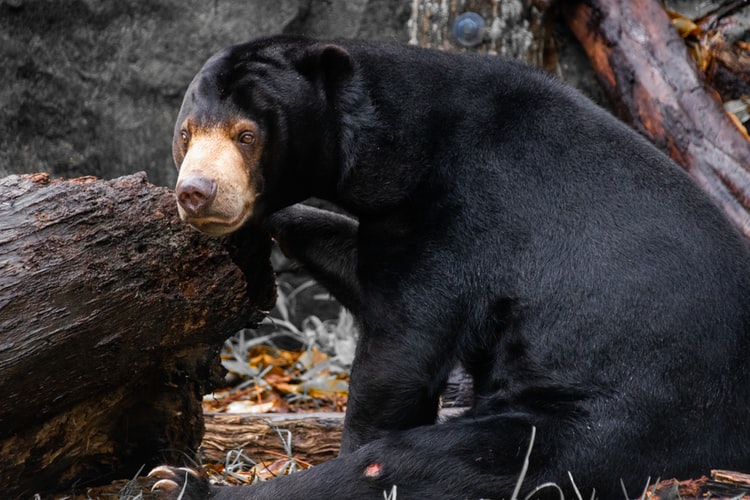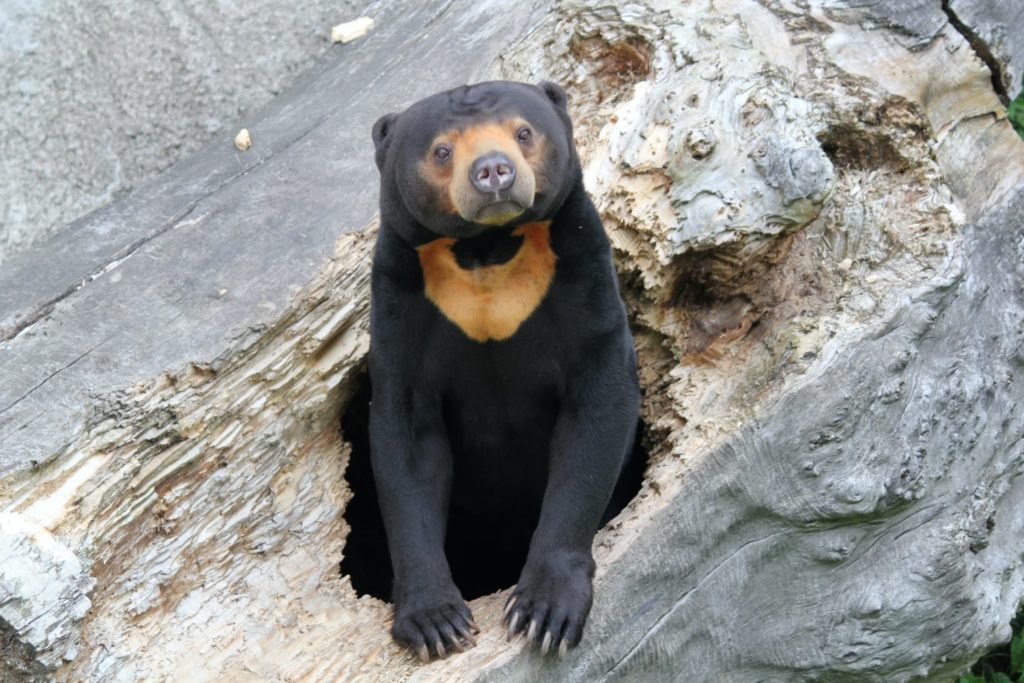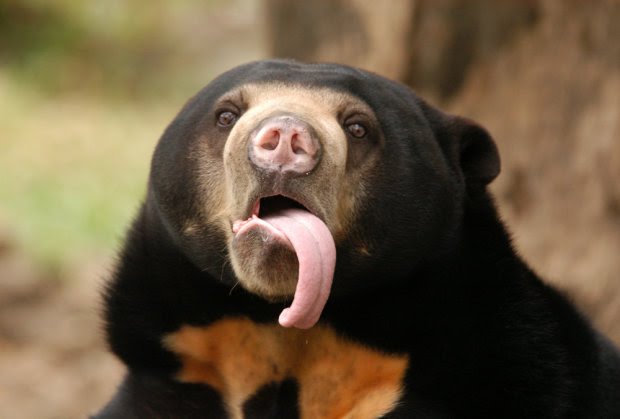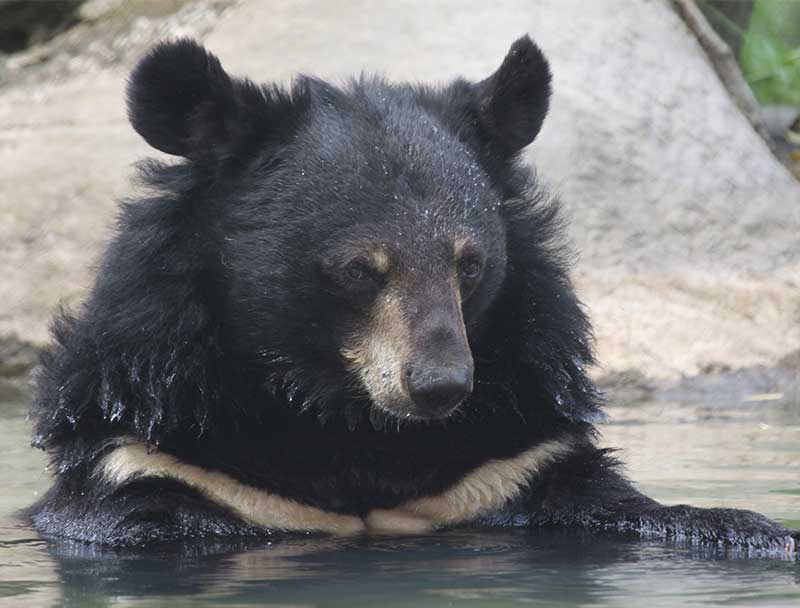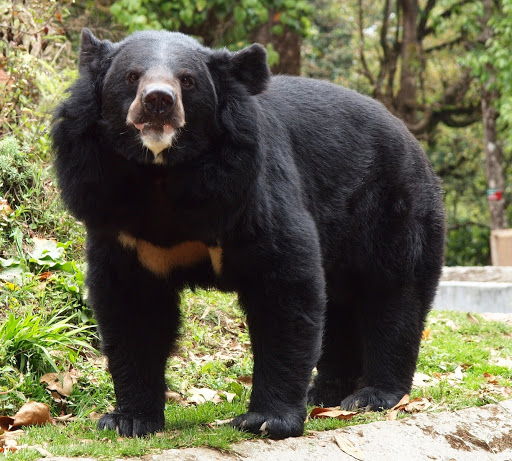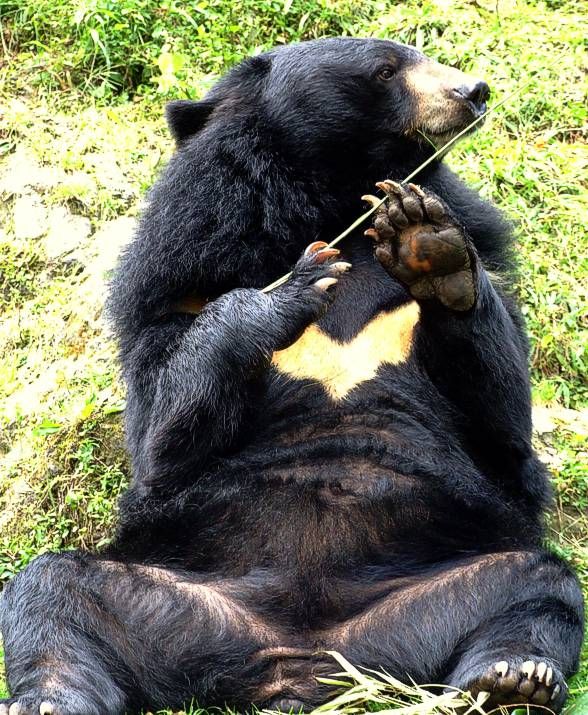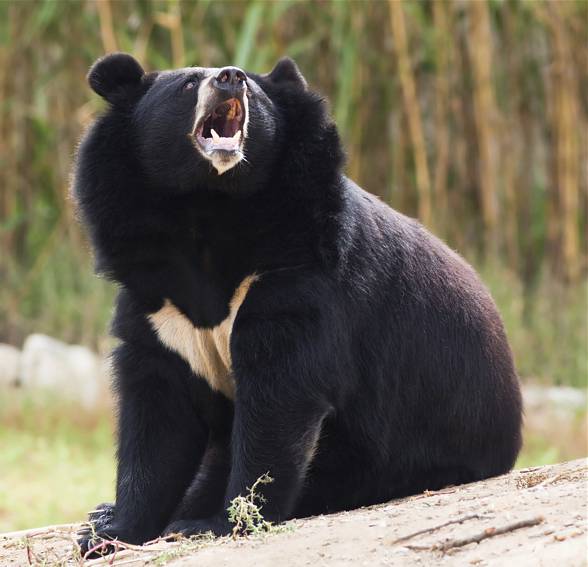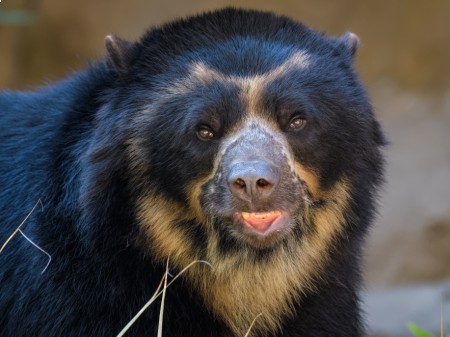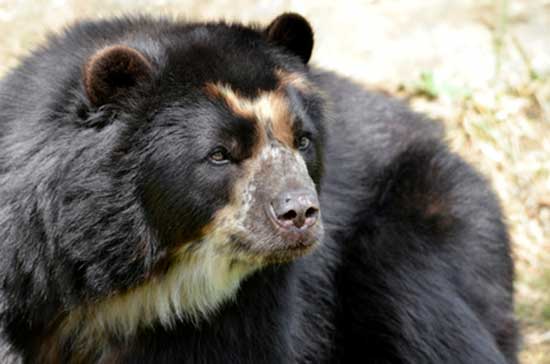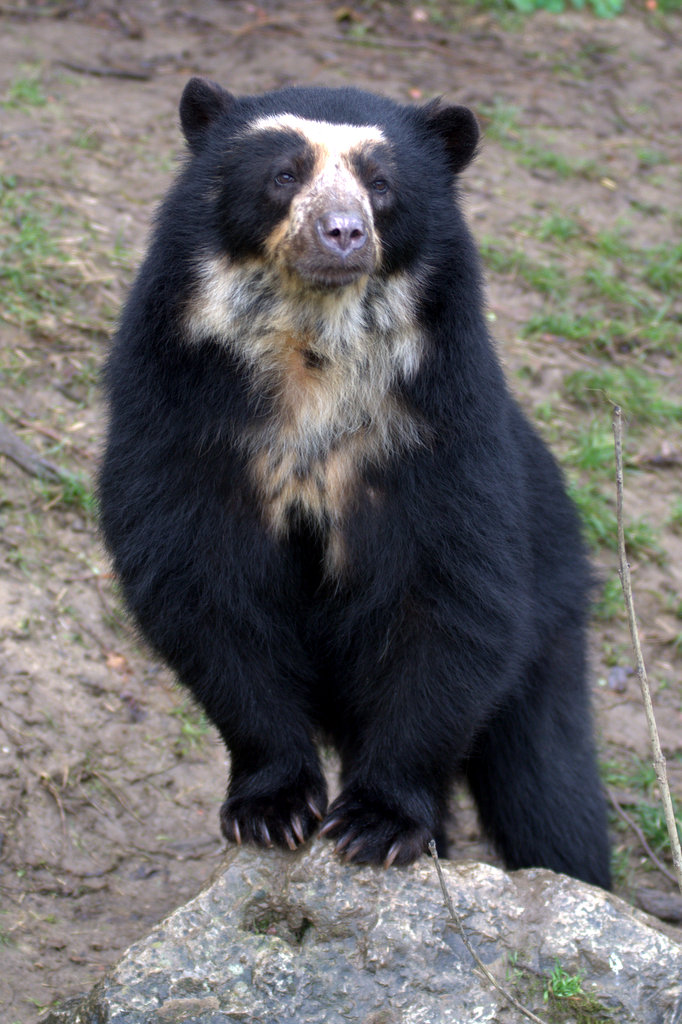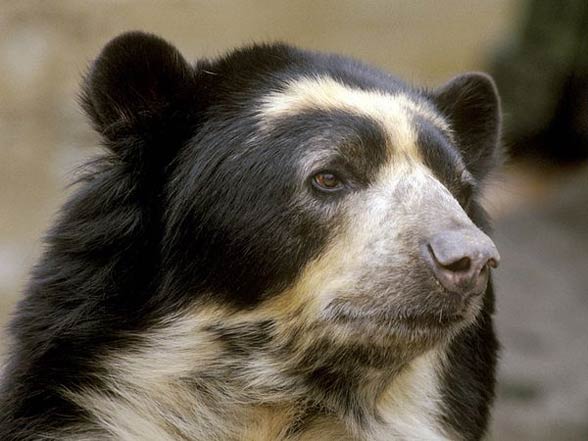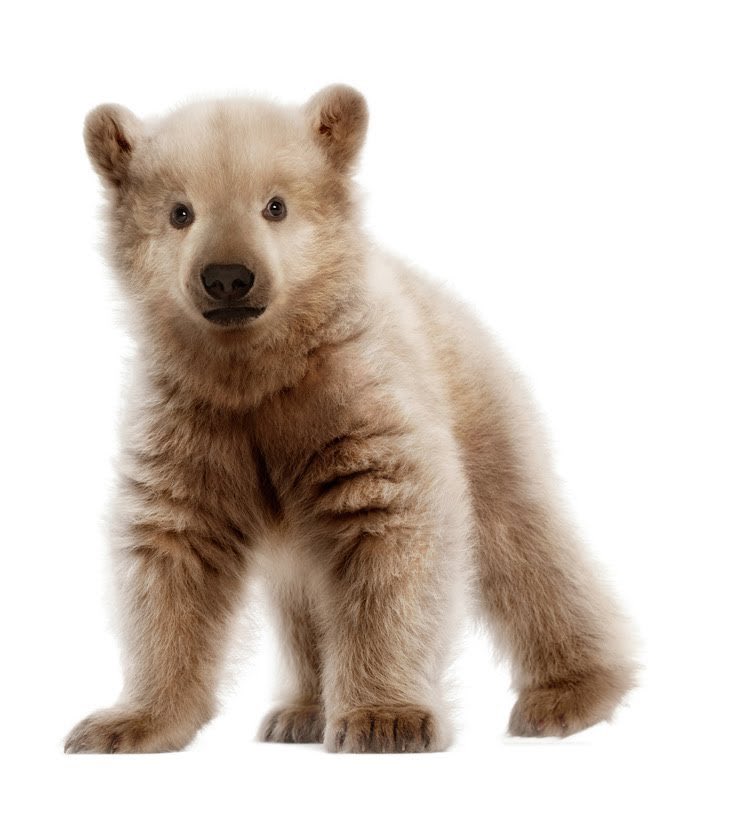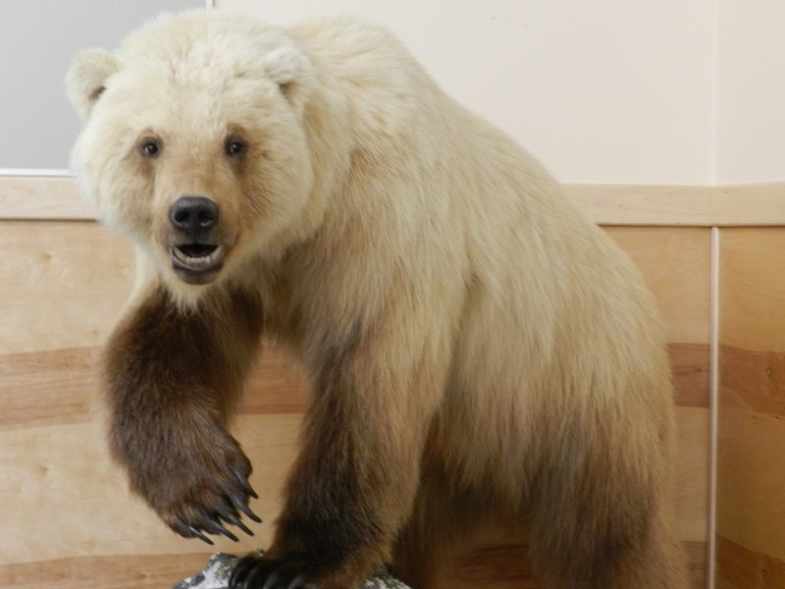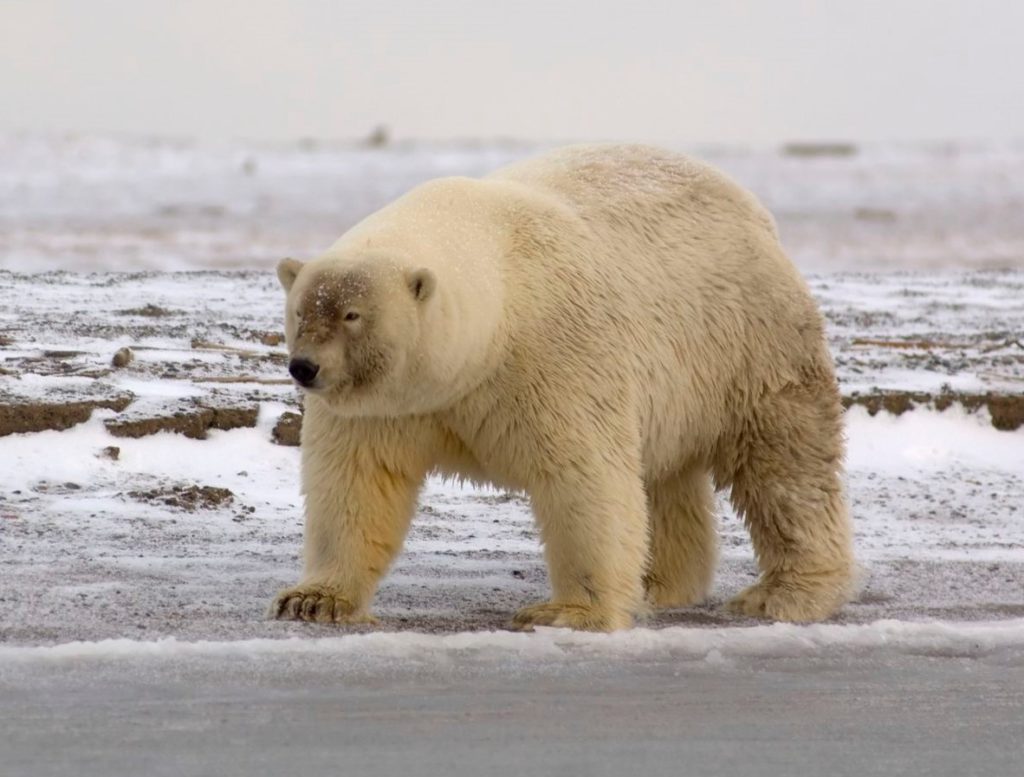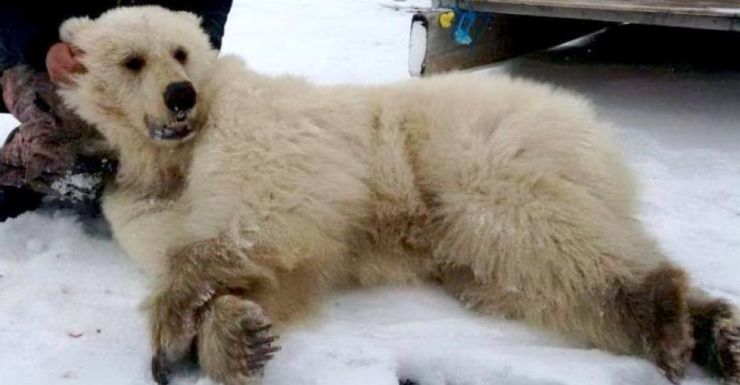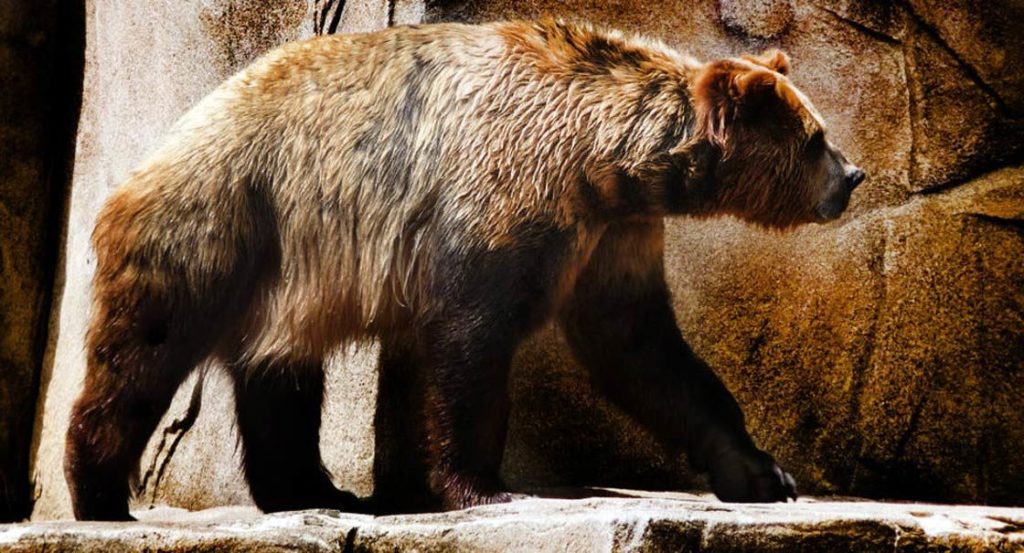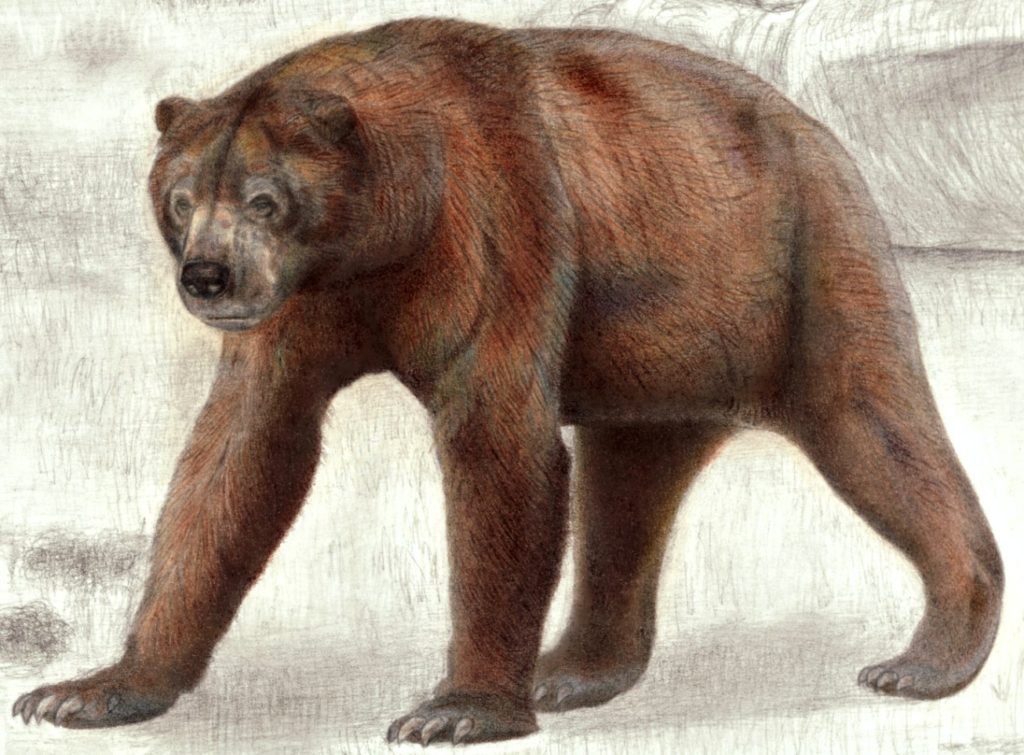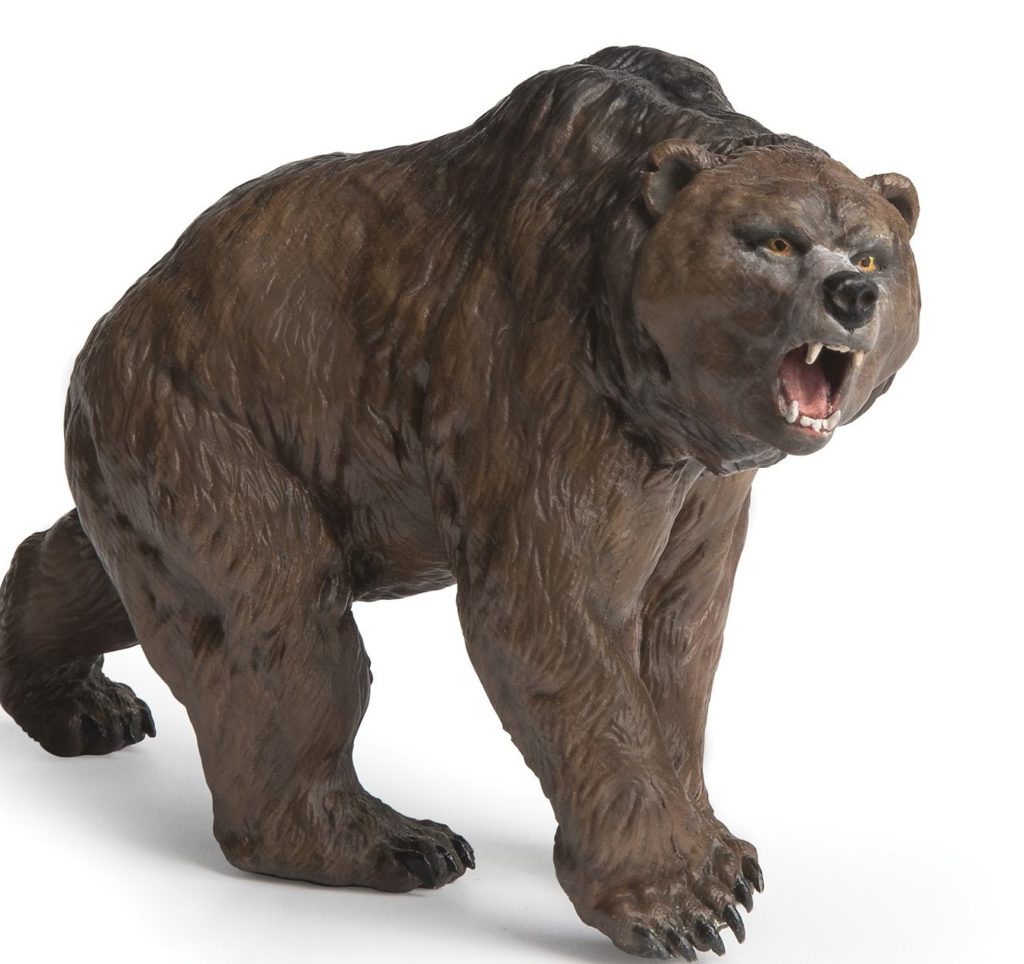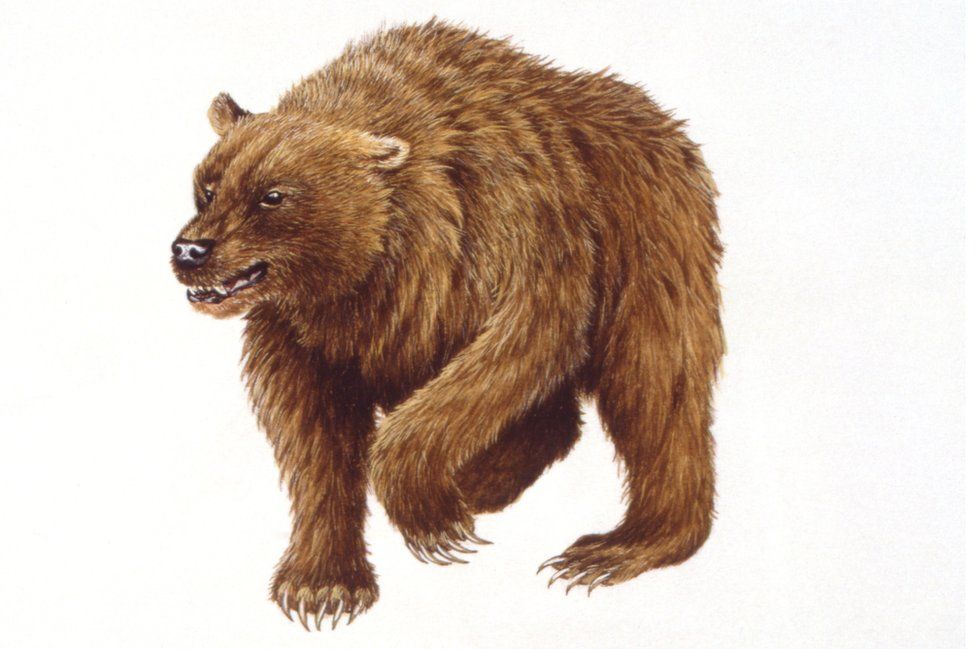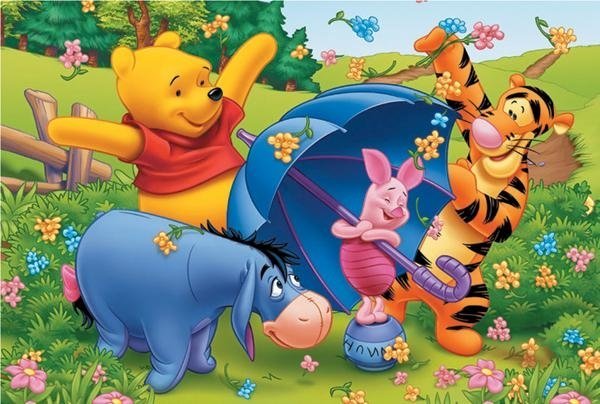Bears are animals belonging to the bear family (Ursidae). Although we currently have eight bear species on the globe and there are significant differences between them, they are all animals of considerable size (from several dozen to even several hundred kilograms, depending on the species), massive, with a short neck and elongated head, with a undeveloped tail and strong, short paws. Bears are considered omnivores (eat meat and plants) (except for the polar bear (carnivore), and the giant panda, which feeds entirely on plant food (herbivore)).
If we had the opportunity to look at the bear closely, our attention would certainly be drawn to its strong teeth. Large daggers, strong canines, and massive molars are teeth that can chew, tear, and grind any kind of food. The huge claws designed to fight and dig in the ground are designed to frighten the opponent. Furr, which is so distinctive for all bears is always uniformly colored (except for the two-colored, black and white giant panda), thick, long and dense hair, combined with a good-looking pair of relatively small eyes and a large, black nose, made bears long-time beloved animals of children. Although they are rather dangerous animals, the teddy bear has been the best friend of every toddler for generations. And the bear, unaware of the sympathy it has among the youngest members of the Homo sapiens species, does not seek contact with humans. If it is not disturbed in its natural environment, it will not attack itself. However, if it feels the need to fight for her territory, the bear uses a whole range of interesting tools. Perfect sense of smell, which is the most important bear sense; the ability to quickly run, swim or climb trees; if necessary, they can also act in a two-footed position, especially when it comes to scaring the opponent.
Bears inhabit all continents except Africa and Australia. Those living in a temperate or cold climate fall into the so-called Winter sleep. This is a state like hibernation; however, the animal’s body temperature does not drop drastically and can be easily awakened. A bear’s sleep may last up to six months, however, due to the increase in ambient temperature, it may be interrupted. Similarly, when the arrival of winter is delayed, the bears are in no hurry to choose a place for winter rest.
The mama bear, depending on the species and other elements, gives birth to 1-4 young every 1-4 years. Bears stay with their mother for about three years, after which they choose a solitary lifestyle before they reach sexual maturity. Then they pair up only for the period necessary for reproduction. Males do not take part in raising their offspring.
In their natural environment, bears live up to 25 years, if they manage to survive their childhood, when they are most vulnerable to attack by predators and … other bears. Some examples living up to 50 years were recorded in captivity.
Brown bear ( Grizzly)
The brown bear (Ursus arctos) is a very distinctive animal and, thanks to its thick, brown hair, despite being a large predator, has always aroused sympathy. As previously mentioned, it is a powerful animal – adult individuals weigh up to 1763 pounds (800 kg). Males are more massive than females, but these are also not the smallest ones, as their weight oscillates around 440 – 660 pounds (200-300 kg).
Brown bear Pregnancy lasts 8 months and results in 2 to 3 young are born. Childbirth occurs during the female’s hibernation sleep, usually between December and February. The little ones are born completely dependent. They spend the first weeks of their lives tucked into their mother’s fur so tightly that they do not even touch the ground, which allows them to survive in a cold environment. In captivity, the brown bear can live up to 40 years, but in the wild, the life expectancy of this species usually does not exceed 25 years.
The brown bear is not too picky. It is truly omnivorous animals – it does not say no to: berries, snails, bird eggs, earthworms, seeds, but also larger forest game. Its indiscriminate nature makes it the most widespread bear species – it is found in Northern Europe, Asia, and North America. Formerly inhabited all of Europe, but most of it was exterminated. Currently, the number of brown bears in the world is estimated at approx. 200,000.
Bears have poor vision in the dark, so their main activity time is in the afternoon. Everyone knows the brown bear’s habit of hibernating in lairs – specially prepared cave lairs. Lack of food and hunger can contribute to attacks on livestock and even people, who have no chance against this powerful animal. Consequently, winter mountain hikers are advised never to try to feed or “trying to befriend” apparently non-aggressive animal. There are cases where such ideas had a tragic end. The brown bear has a very characteristic way of marking the territory: first, he rips the bark off the trees with his claws, then he rolls in his own urine and rubs against the bare tree.
Polar bear
The polar bear (Thalarctos maritimus), also called white, belongs to the bear family and, like other bear species, is a mammal of significant size. However, unlike its cousins who live in other, more flora-rich continents, the polar bear only eats meat. No wonder, after all, in the Arctic, that is where it appears, other animals are the source of any food. A hungry individual can eat even 130 pounds (60 kg) of seal meat at a time! By eating so much, it stores a thick layer of fat under the skin that protects it from the cold. These animals travel hundreds of kilometers each year in search of food, risking out into the icy sea and returning to land when the ice sheet begins to shrink. Despite the harsh climate, the Arctic is not a wasteland at all. Its waters are home to seals, narwhals, beluga whales and walruses. All these animals are a food source for polar bears.
Among other bears, whose coat is rather dark, Polar bears are distinguished by white or cream fur. This color serves as a camouflage, as most of the year the areas where polar bears live are covered with a thick layer of snow. Therefore, these animals are perfectly adapted to low temperatures. Waterproof, thick, dense hair and a powerful layer of internal fat protect the bear from cooling down, the more that it spends a lot of time in the icy water – hunting. The short tail and small ears also reduce heat loss. His streamlined body shape makes him an excellent swimmer. It was used to know under the name “sea bear”, which translates to his Latin name Thalarctos maritimus. As often as in water or on land, a polar bear spends its time … drifting on a crash. It is his way of traveling across the Arctic, and unrivaled when it comes to gaining food.
The polar bear is currently one of the largest land predators in the world. Both males and females (although these are usually twice as small!) Weigh up to 1000 pounds. For this reason, and since they attack people quite often, they have been influencing the imaginations of travelers for centuries. Unfortunately, it has always been associated with completely unjustified acts of aggression towards polar bears, when, for example, humans killed young bear cubs. Hunting and changes in the natural environment of a polar bear have a damaging effect on their population size. Scientists are alarming that this global warming may largely contribute to the disappearance of this species from the face of the earth. The ice floes on which bears move during the gathering of food (hunting for seals and fish), as well as for the purpose of finding a mate for reproduction, melt. The more so that in the case of this species, pregnancy lasts an exceptionally long time (even 265 days) and usually only two babies are born, extremely exposed to various dangers.
Male polar bears are solitary hunters. Females and their young form small family groups. Both sexes meet only in the spring, during the mating season. Most bears hibernate in colder climates, but the polar bear remains active all year round.
*April – May: The young stay with their mother for over two years. This means that the female mates only once every three years, leading to intense fights between the males.
*November – January: A pregnant female digs a lair and hides in it to give birth to cubs. Two, rarely three, very infirm bears are born, but they grow quickly, fed with their mother’s milk.
*February – April: At three to four months of age, the baby bears are large enough to come out of their den. They stay with their mother for two and a half years. It takes them this long to learn to hunt in arctic conditions.
*April – July: In winter, food was scarce, so bears eat young seals (a species of seal), which are abundant in late spring. Often, they only eat subcutaneous fat and leave the rest.
The millions of seals are the delicacy of polar bears. Arctic carnivores spend most of their time hunting marine mammals to build up the necessary fat stores. A favorite place for bear hunting is the edge of the ice sheet. They sense seals thanks to their excellent sense of smell and hearing. With their structure and customs, polar bears reflect the unusual environment in which they live. White fur is the perfect camouflage, making it easier to sneak up near seals, their favorite food. Thick hair protects bears from the cold. The top layer consists of hollow, water-repellent hair. There is another 4 – 5 inches of fat under the bottom layer of fur. Curved claws make it easier to burrow in ice and catch seals. The wide paw is perfect for walking on ice and swimming.
The giant panda (Ailuropoda melanoleuca), sometimes called the bamboo bear (it feeds mainly on bamboo shoots; therefore, its existence is limited to the bamboo forests of the People’s Republic of China. The giant panda, although it occurs in a relatively small area of only one continent, is known all over the world. Its image has become a symbol of the World Wildlife Fund, an organization dealing with the protection of endangered species. In addition, the giant panda is the central character of many animated films for children and books, probably every toddler in the world has ever had a plush mascot resembling this Chinese bear. And although the giant panda is so sympathetic, it is an endangered species. The basis of the giant panda’s diet (although it does not hate even rodents or bird eggs) are bamboo shoots and nothing can replace it – this animal needs even tens of pound of leaves of this plant per day. Consequently, this species is threatened with extinction – bamboo forests are lost forever because of human economy. The giant panda consequently loses its food source, shelter, and breeding environment.
The latest research also indicates a new threat to the animal. Scientists believe that the threat to the giant panda is not a lack of food. However, it is threatened by high ambient temperatures, which is more and more common in the context of global warming. The current bamboo resources are sufficient to support the giant panda population. Researchers have noticed that these bears experience stress when the ambient temperature exceeds 25 degrees Celsius. To be healthy, they must live in lower temperatures. In summer, in their natural environment, they look for places with a cooler microclimate and wander to higher altitudes. Giant pandas can spend up to twelve hours a day searching for food. They mainly eat young bamboo shoots and bulbs. Their front paws have an extra bone, like a sixth finger, which pandas can use just like we do with our thumb. Thanks to this outgrowth, they cover up, for example, branches and hold food.
The breeding of the giant panda is not fast – it becomes mature at the age of 5-6 years, and the mating season lasts only two months a year – from March to May. Pregnancy lasts 97-163 days, and because of it, up to three babies are born, of which almost always only one survives. The young panda separates from its mother at the age of about 18 months, so the female can give birth to and raise the young at 2-3-year intervals. An additional threat to the species is the mortality of young pandas that have just died – they very often fall prey to predators. Only at the age of about 3, the panda is so big and strong that it ceases to have any natural enemies.
Why are pandas black and white? The black and white coat of the giant panda is used for camouflage and communication. Analyzes of the fur color and the background of the pandas’ environment show that the white snout, neck, back, sides, belly and rump help hide in the snow, while the black front and back paws in the shade. The black spots on the face are used for communication – they scare away predators, and the patches around the eyes make it easier for bears to recognize each other.
American Black Bear ( Baribal)
Baribal (Ursus americanus), also called the American or black bear, appears in North America – from Mexico to Northern Canada. This powerful animal (adults weighing about 800 pounds) has a very dark, almost black coat, which, however, also has various shades of brown, from tan to cinnamon. It has mastered the ability to climb trees on which they seek shelter and food. And when it comes to their menu, it is extremely varied – plants, fruits, mushrooms, seeds (plant food accounts for 95% of the diet!), But also fish, tissue, insects, bird eggs, chicks, sometimes pets – everything can be American bear delicacies.
The mama bear pregnancy lasts 7-7.5 months. The female gives birth to 1-4 cubs, which, like all bears, are exceedingly small (weighing about 0.66 pounds), blind, deaf, and hairless. For a period of 12-16 months, they suckle their mother’s milk, gradually learning to find food from the environment. They reach maturity at the age of less than 3 years.
The American bear is active mainly at night. He leads a solitary lifestyle. They hibernate, which differs slightly from the “standards” of other bears. During winter rest, Baribal’s body temperature decreases slightly, only by 1-2 degrees C, but the pulse rate is reduced by more than half. The metabolism is also slower – the animal does not pass feces or urine for over 4 months, and does not eat any food, using the stored fat reserves. Remarkably, it is during the mother’s winter sleep that babies are born into the world. They spend the first months of their lives drinking milk and cuddling with their sleeping mother.
*March – May: Young bear cubs leave the den for the first time.
*June – August: Mating season, but the fertilized eggs do not begin to develop.
*September – November: Nutrition. If the female “collects” enough fat, the embryos develop.
*December – February: During sleep, the female gives birth to two to four cubs.
Sloth Bear
Sloth Bear (Melursus ursinus), It has also been called “labiated bear” because of its long lower lip and palate used for sucking up insects. Lives mainly in India, Nepal, and Sri Lanka. Until the 90s of the twentieth century it was a species quite common in these areas, now it is threatened with extinction. It lives in wooded and grassy areas. Although it is classified as a predator, its diet consists mainly of plant-based foods. It enthusiastically eats termites – its body, equipped with long and strong claws, as well as the characteristic lips that can form a “suction tube”, seems to be perfectly adapted to obtaining these insects.
The Sloth bear is an animal that is easy to tame, but there have been cases of attacks by these bears on people, including “keepers”. An unarmed man has no chance against it! A large animal can weigh up to 350 pounds and can be extremely aggressive. Contrary to many other bear species, Sloth bears do not live alone – family units of these animals usually consist of 4-5 animals. There are no fixed mating time frames during the year. A female can become pregnant at any time of the year, although this is most common from April to June. After 7 months, 1-3 babies are born, completely dependent on their mother. Interestingly, they move on mama’s back, and travel this way. This bear lives up to 30 years in natural conditions. It is noteworthy that the male mates with one partner to whom he is faithful throughout his life.
Malay bear (Sun Bear)
The Malay bear (Helarctos malayanus) is one of the smallest bear species – an adult individual, regardless of sex, reaches the weight of a large dog – about 80 pounds (35 kg). Males are usually 10-20% more substantial than females. This species is one of the least known bear bears. It is known to thrive in the rainforests of almost all of Asia. Their short, dense fur allows them to live in this not very favorable climate (hot and humid almost all year round). Mastering skills, such as climbing trees (exceptionally long claws and hairless feet allow a firm grip and hold the whole tree trunk). They are building sleeping nests among branches. Malay bears are active mainly at night and they rest during the day, or search for nectar from flowers, prove the perfect acclimatization in this ecosystem. Importantly, Malay bears do not hibernate. It is known that the pregnancy lasts about 95 days, but there are known cases of its extension. The female usually gives birth to one or two young, occasionally more. Newborn babies of the Malayan bear are blind, deaf, and fully dependent on their mother’s care. They stay with it until they reach sexual maturity at the age of about 3 years.
Himalayan bear (Asiatic Black Bear)
The Himalayan bear (Ursus thibetanus), also known as the lunar, Tibetan or collar bear, is a species very closely related to the Americana bear. It lives in forests in mountainous areas of almost the entire area of the Asian continent. Its distinctive, dense black coat with a white V-shaped mark on the chest makes it impossible to confuse the Himalayan bear with any other species.
Himalayan bear Adult males can weigh up to 330 pounds, but females are smaller and do not weigh more than 200 pounds. Despite their large size, these animals are extremely alert – they move quickly on the ground, they can also climb rocks and trees perfectly, in whose crowns they build their nests in the shape of a platform. Tree branches are an excellent source of food for this species. Himalayan bears are omnivores. They feed on fruit, bamboo shoots, bird eggs, bulbs, honey, and meat. They are considered an overly aggressive bear, attacks on humans are frequent. This is because of the increasing occupation of bear territory by humans. The Himalayan bear leads a distinctly solitary lifestyle. Individuals of different sexes mate only during the mating season. After 7 months of pregnancy, the female gives birth to 2 to 4 young, who leave her after 2 years and begin independent life. Himalayan Bear life expectancy is usually around 25 years.
The Himalayan bear is on the verge of extinction because of hunting. The meat of this animal is considered a delicacy, and although killing it is prohibited by law, many poachers are doing it illegally anyway. Additionally, according to natural medicine from some parts of Asia, it is believed that the claws and gallbladder of this animal have healing powers. Malay bears are also killed for sport. Despite the trade ban and the protection of this species, poaching does not bode well for the survival of the Malay bear in the wild.
Andean bear (Spectacled Bear)
The Andean bear (Tremarctos ornatus) is also called the Peruvian bear (due to its place of existence) or the spectacled bear (due to the characteristic “ eyeglasses” of light brown color, contrasting with the black color of the rest of the species’ body). The Andean bear lives in the mountainous regions of the western part of the South American continent, regions of Bolivia, Ecuador, Peru, and Venezuela. Males may weigh up to 200 pounds, but females do not reach this size and weigh no more than 140 pounds. Although the diet of the Andean bear is rich in fruit, shoots, and leaves, it also does not despise a small animals. Andean bear It sometimes attacks larger species (deer), but rarely alone. The Andean bear sometimes chooses a solitary lifestyle, but usually there is a miniature group of several animals. The Andean bear is one of the endangered species. It is covered by a special international breeding program, with the addition of other zoos, aimed at supporting the reproduction of this species. As a result of a pregnancy lasting 8 months, the female usually gives birth to one, sometimes two or three young. They reach sexual maturity at the age of about 3 years. Data on maximum life expectancy in the wild are lacking, but in captivity Andean bears live an average of 30-35 years.
Pizzly Bear
Pizzly Bear (Ursus maritimus × Ursus Arctos)
Sometimes called: Grolar Bear, Polar Grizz, Polizzle, Pizzly Bear, Grizzlar or Nanulak.
A hybrid, a unique representative of bears, which is a cross between a brown bear and a polar bear. Unlike other hybrids, pizzly is found in the wild. It looks like both parents. The fur is mostly white, but there is a darker coat around the eyes, mouth, back and legs. The hair is longer than the grizzly hair, but shorter than the polar hair, and has properties of both species. A similar thing is with claws. These can be used both for walking on ice like a polar bear and for digging in the ground like a grizzly bear. In addition, from brown bears they inherited: a larger head and shoulder structure, and from the other side they got: hairy soles of the feet and a longer neck.
Their behavior is more like polar bears. Their way of moving and lying down is characteristic of “polar men”. Due to the fact that individuals were observed in winter, when brown bears hibernate and a full belly in one of the individuals, which would be difficult to fill with plant food during this season, it is safe to assume that their diet consists mainly of seal meat. But what does their diet look like during the summer? We can only guess. Perhaps then the bear diet looks more like an omnivorous grizzly bear?!
Second-generation hybrids have also been observed, so we know that at least one sex of the offspring retains fertility. The exact time of the hybrid’s pregnancy is unknown, but it is probably like polar bears and grizzly bears.
The sizes are somewhat between a brown bear and a polar bear. The observed individuals were smaller than the Polar original but slight bigger than the Grizzly.
Extinct species of bears:
*Short-faced bear
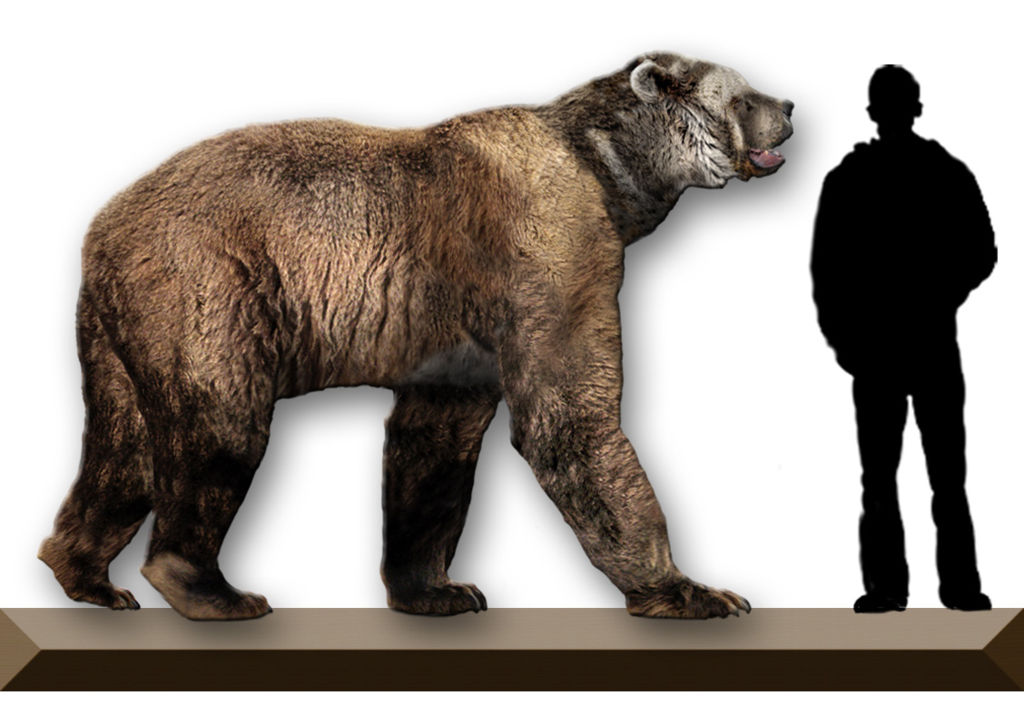
The short-faced bear (Arctodus simus) belongs to the extinct mammals of the bear family. His remains have been found in North America. It is estimated that it became extinct about 11 400 years ago, after the last so-called glacial maximum. The short-faced bear weighed about 2200 pounds (1000 kg), was the most powerful predator in North America of the Pleistocene epoch (geological epoch that lasted from about 2,580,000 to 11,700 years ago ), and also probably the largest bear ever living on Earth. Studies of his teeth show that the short-faced bear ate almost exclusively meat. Probably he specialized in hunting caribou an animal of the deer family. The structure of the bones would suggest the ability to run fast, and the size – to fight other predators (hunting grounds, game).
*Cave bear
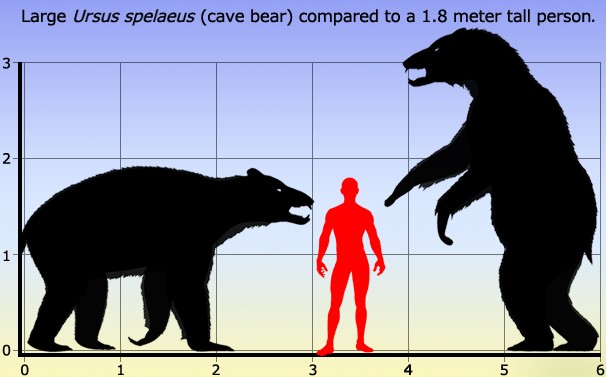
The cave bear (Ursus spelaeus) is another of the extinct bear species. It lived in Europe in the Pleistocene period (geological epoch that lasted from about 2,580,000 to 11,700 years ago). It is believed that it finally died out in the Ice Age, around 28,000 years ago. Its name reflects the fact that its remains were found mainly in caves, which probably meant that the animal spent a lot much more time in the caves than the present-day brown bear (which uses the caves only as a place for winter sleep).
Cave Bear Bones have been found all over Europe. Research shows that the cave bear was approx. 30% larger than the currently living brown bear. Unlike modern bears, the cave bear was exclusively herbivorous, as evidenced by its teeth.
For a long time, it was believed that the cave bear died out only because of the Baltic glaciation, to which the species was unable to adapt. The latest research shows that Homo sapiens is largely responsible for the extermination of this animal. Modern man used better tools for hunting and entered caves inhabited by the bear. People could hunt cave bears for meat, fur and to eliminate a potential threat. As humans reduced the cave bear population, individuals became more isolated from each other, and the species’ genetic pool diminished, making it more vulnerable to disease. An additional cause was the advent of the ice age. As the cave bear mostly fed on vegetation, climate change made it difficult to find food.
